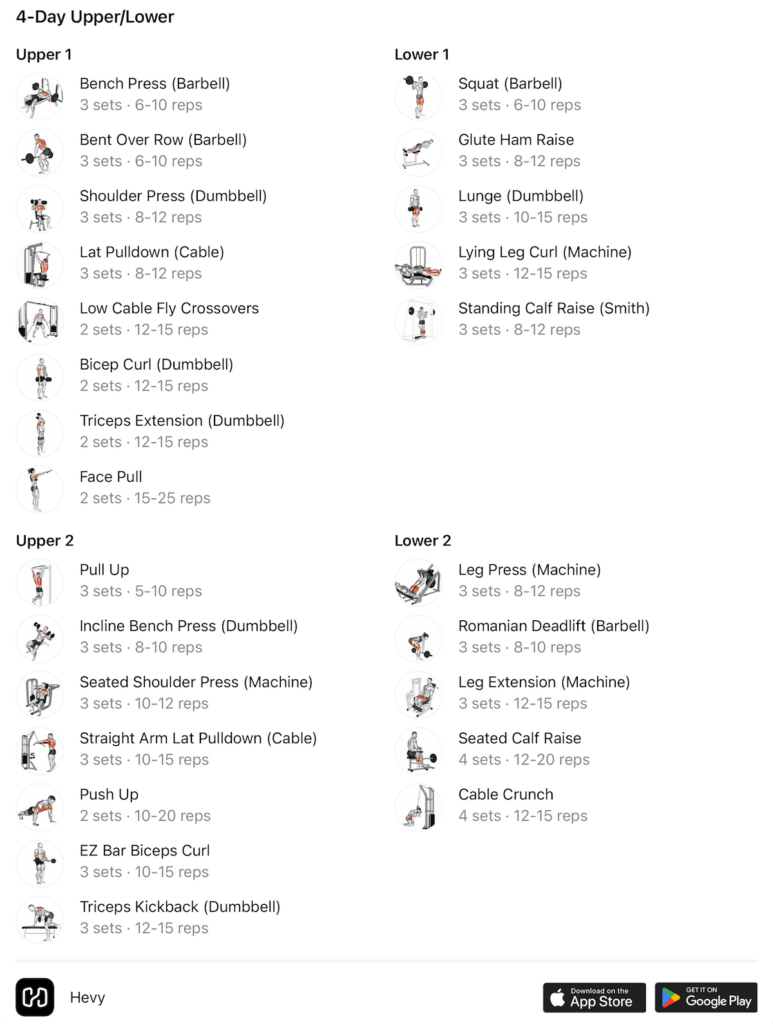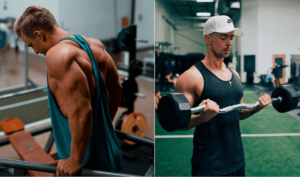What Is The Upper/Lower Split?
The upper/lower split is among the most popular ways to organize your training. The idea behind it is very simple: You split your training into upper-body exercise days and lower-body exercise days. The most common way is to spread your weekly training volume across four workouts – two upper, and two lower. For example:
Weekly Schedule
Monday – Upper
Tuesday – Lower
Wednesday – Off
Thursday – Upper
Friday – Lower
Saturday & Sunday – Off
On Upper days, you will work out all the major muscle groups like back, chest, biceps, triceps, traps, and abs. On the Lower workout, you will train the lower body’s major muscles – glutes, hamstrings, quads, and calves.
Hevy Workout Tracker
Create your own workout splits with Hevy, and track your progress. Join 5M+ athletes.
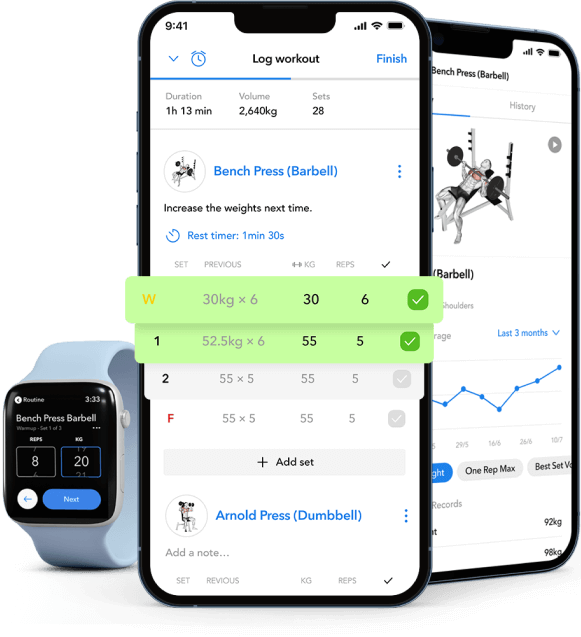
For Personal Trainers
Personal trainer software to build programs for your clients, and track their progress.
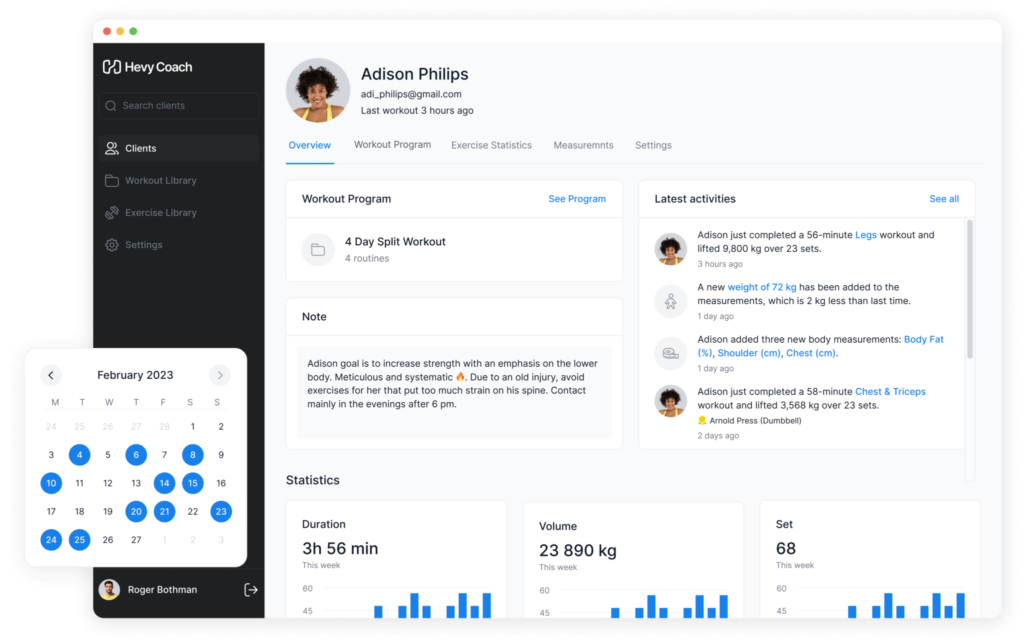


People tend to have multiple variations of an Upper or a Lower routine so that they can perform different exercises and workout muscle groups at different intensities depending on the workout.
4-Day Upper/Lower Workout Overview
Let’s get more practical and take a more in-depth look at the gold standard of the Upper/Lower split – training four days per week.
Weekly Schedule
Monday – Upper
Tuesday – Lower
Wednesday – Off
Thursday – Upper
Friday – Lower
Saturday – Off
Sunday – Off
This is the classic upper/lower split that most people are familiar with. It’s fantastic because you have a consistent schedule from week to week, you get to train each muscle group twice weekly, and the frequency is not overwhelming (7).
Click here and tap Save Folder to save this split to your Hevy profile. Download Hevy here if you haven’t already, create your free account, and use the same credentials to log in to hevy.com, so you can save the program.
Here are four upper/lower workouts you can alternate in your weekly schedule.
Upper 1
• Bench Press (Barbell) – 3 sets of 6 to 10 reps
• Bent Over Row (Barbell) – 3 sets of 6 to 10 reps
• Shoulder Press (Dumbbell) – 3 sets of 8 to 12 reps
• Lat Pulldown (Cable) – 3 sets of 8 to 12 reps
• Low Cable Fly Crossovers – 2 sets of 12 to 15 reps
• Bicep Curl (Dumbbell) – 2 sets of 12 to 15 reps
• Triceps Extension (Dumbbell) – 2 sets of 12 to 15 reps
• Face Pull – 2 sets of 15 to 25 reps
Lower 1
• Squat (Barbell) – 3 sets of 6 to 10 reps
• Glute Ham Raise – 3 sets of 8 to 12 reps
• Lunge (Dumbbell) – 3 sets of 10 to 15 reps (per leg)
• Lying Leg Curl – 2-3 sets of 12 to 15 reps
• Standing Calf Raise (Smith) – 3 sets of 8 to 12 reps
Upper 2
• Pull Up – 3 sets of 5 to 10 reps
• Incline Bench Press (Dumbbell) – 3 sets of 8 to 10 reps
• Seated Shoulder Press (Machine) – 3 sets of 10 to 12 reps
• Straight Arm Lat Pulldown (Cable) – 3 sets of 10 to 15 reps
• Push Up – 2 sets of 10 to 20 reps
• EZ Bar Biceps Curl – 3 sets of 10 to 15 reps
• Triceps Kickback (Dumbbell) – 3 sets of 12 to 15 reps
Lower 2
• Leg Press (Machine) – 3 sets of 8 to 12 reps
• Romanian Deadlift (Barbell) – 3 sets of 8 to 10 reps
• Leg Extension (Machine) – 2-3 sets of 12 to 15 reps
• Seated Calf Raise – 3-4 sets of 12 to 20 reps
• Cable Crunch – 3-4 sets of 12 to 15 reps
This routine is fantastic for early to late intermediates, and you can use it to make great gains for many years. What’s more, your muscles have enough time to recover before you have to train them again, and there aren’t many consecutive training days.
This is a relatively strict upper/lower split, with a couple of exceptions. On your Lower 2 workout, you also do some direct ab and trap work, as adding them to your upper days would make these workouts even longer and more fatiguing.
As for warming up, you should always prepare your entire body for both types of workouts. This will help maximize your performance and minimize the risk of injury. A bit of light cardio, followed by some dynamic exercises, should be enough. Then, take your time to work up to your training weights on the first exercise.
The Hevy app has a warm-up set calculator you can customize to your preferences (or stick with the default formula) and use to add multiple sets to any exercise with a single tap.
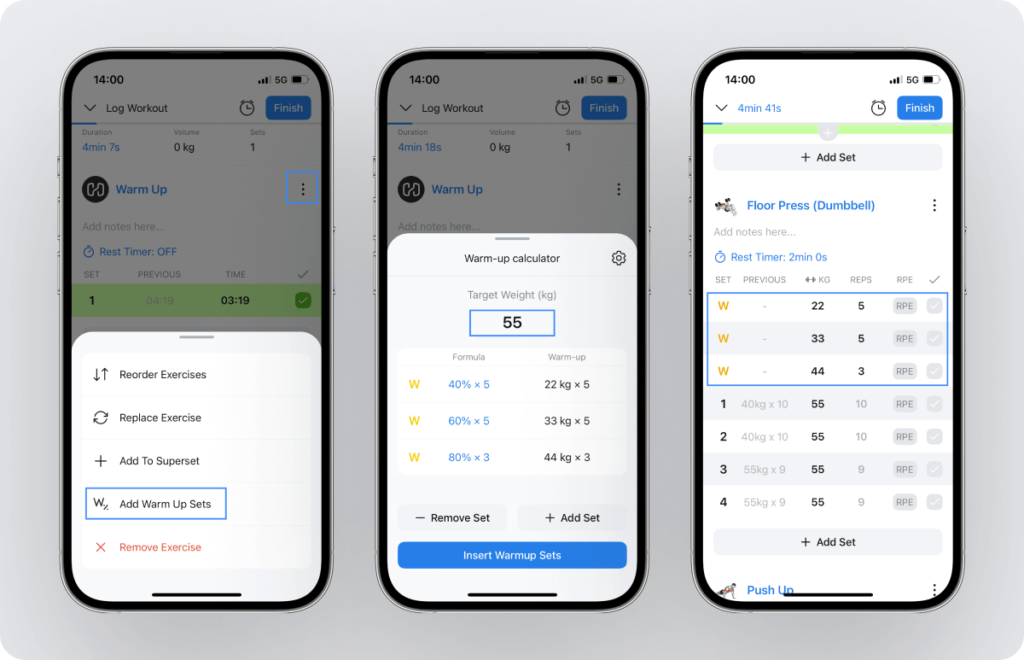

As far as rest between sets goes, you should rest for as long as you need so that you can do your prescribed repetitions on each set (8). For example, if you do ten reps on set one, you should get at least eight on the last. If you can’t, you’re either training too close to failure or not resting long enough.
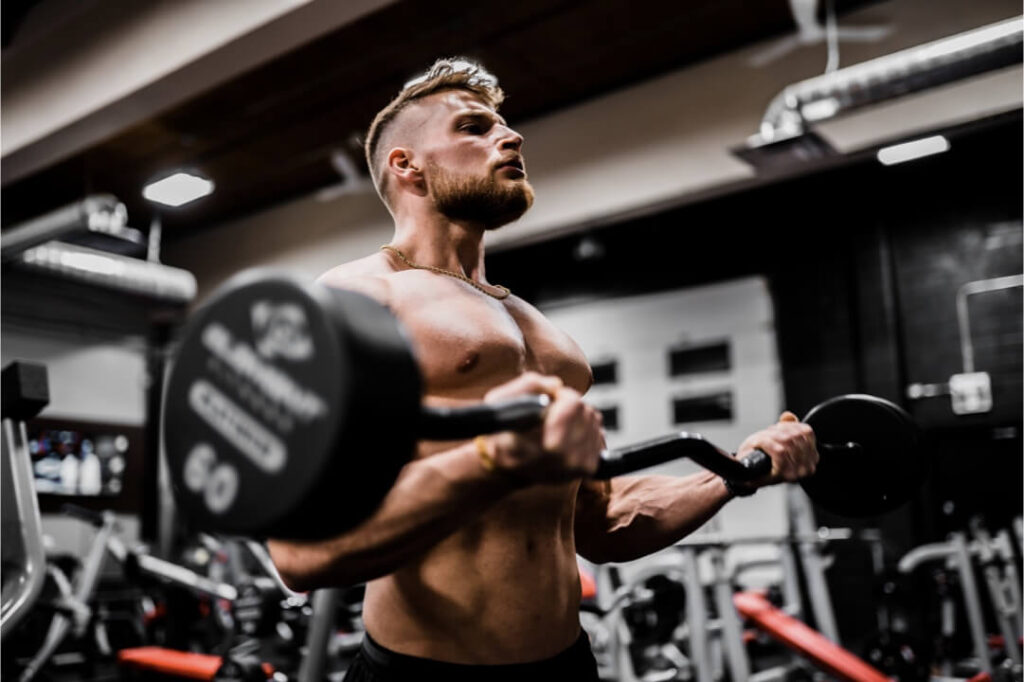
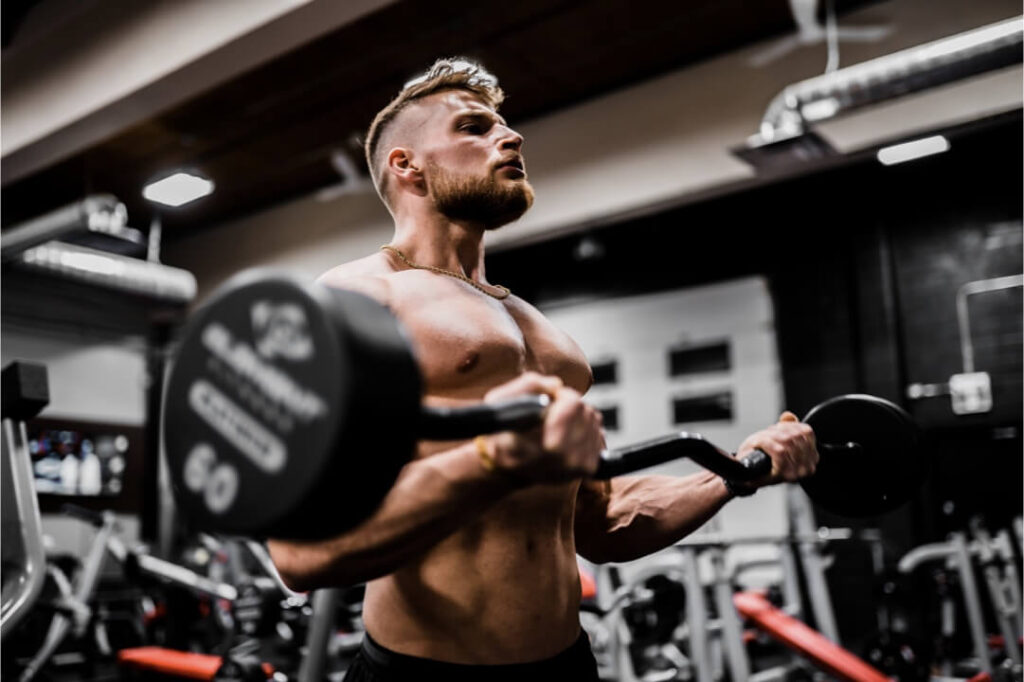
The Benefits Of The Upper/Lower Split
While it may seem overly simplistic, the upper/lower split offers numerous benefits related to volume allocation and muscle growth. Let’s take a look:
1. It Works With Multiple Training Frequencies
The issue with most splits is that you’re more or less limited to a particular training frequency. However, the upper/lower routine is great because you can use it for at least four distinct training frequencies, which we’ll look at below.
So, whether you can train twice or six times per week, you can make an upper/lower split work for you. Say that you’re a weekend warrior and can only train twice per week – on Saturday and Sunday. While not ideal, you can have an upper-body workout on Saturday and a lower-body workout on Sunday (2).
Alternatively, you might be more interested in a high-frequency program, in which case you could do six workouts per week, with three lower-body and three upper-body workouts, or try German volume training or a PHUL workout plan. This brings us to benefit number two:
2. It Works Well With The Principles of Daily Undulated Programming (DUP)
The “Repeated Bout Effect” states that the more we expose the body to a given stimulus, the less it responds to it (3). The more we train, the more the body adapts, and we see progressively slower results.
For example, the first time we do a bicep exercise, it causes significant disruption – muscle damage and metabolic stress. Our biceps are sore and weak for days. But then, as we do more of this training, it causes a smaller disruption until it no longer causes any significant growth.
At some point, we can train our biceps so hard that we won’t experience even half the effects of training – soreness, weakness, and such.
On the one hand, that’s a good thing – after all, most people prefer not to feel sore and weak from training. But finding ways to keep our training somewhat novel is important for creating a strong growth response.
In other words, we need to experience a fair amount of discomfort from our training to keep progressing over the months and years.
Daily undulated programming refers to the change in training variables (intensity/volume/rep ranges/exercise selection) with the aim of avoiding the “Repeated Bout Effect” (4). The goal is to prevent the body from fully adapting to the training stressors. That way, we can cause larger disruptions and, hopefully, grow more over time.

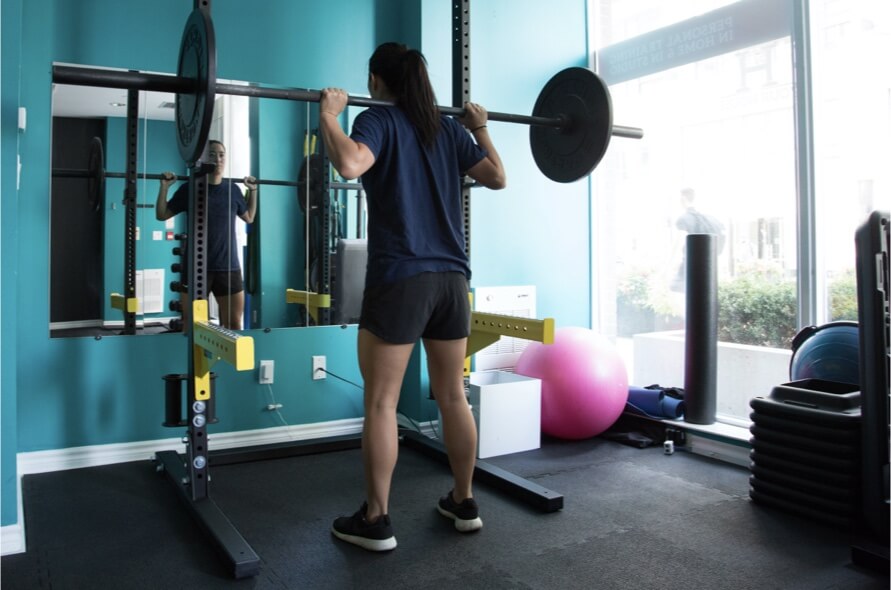
So, instead of changing these variables every so often (say, weekly, monthly, or even less often), we change them for every workout. For example:
Variable Exercise Selection
Monday (Lower) – High bar back squats (3 sets of 8 reps) + calves
Tuesday (Upper)
Wednesday (Lower) – High bar speed squats (7 sets of 3 reps) + glutes
Thursday (Upper)
Friday (Lower) – Low bar back squats (5 sets of 5 reps) + hamstrings
Saturday (Upper)
For example, you can also incorporate block programming elements and prioritize one movement, such as the squat, for four to six weeks. Then start emphasizing another – for example, the bench press, while working to maintain your strength on the squat.
3. It Allows You to Better Focus On Individual Muscle Groups
Setting up an effective training split can be challenging precisely because of the overlap issue. Knowing how to sequence workouts can be challenging, and if we don’t do it right, we can unknowingly hinder our performance.
For example, if you train your chest on Monday and then do a tricep or shoulder workout on Tuesday, you won’t perform as well as you usually do. The reason is that your shoulders and triceps are reasonably involved in chest training and also need time to recover (5, 6).
The great thing about the upper/lower split is that you train the overlapping muscles on the same day and then give them enough time to recover before training them again.
Alternative Scheduling Options for Upper/Lower Workout Split
Everyone will have a different schedule and priority in their training. The great thing about the upper/lower training plan is that it allows you plenty of flexibility in organizing your training schedule. Below, we’ve added two other ways to schedule your upper/lower workout split.
3-Day Upper/Lower Split
| Week 1 | Week 2 |
| Monday – Upper Tuesday – Of Wednesday – Lower Thursday – Off Friday – Upper Saturday – Off Sunday – Off | Monday – Lower Tuesday – Off Wednesday – Upper Thursday – Off Friday – Lower Saturday – Off Sunday – Off |
As you can see, this arrangement spans two weeks. With it, you train your upper body twice in week one, and then your lower body twice in week two.
The great thing about it is that you have excellent scheduling flexibility. The bad thing is that there might not be enough training volume to cause optimal muscle growth or strength gain (learn how training for strength and muscle gain can differ).
5 Day Upper/Lower Split
| Week 1 | Week 2 | Week 3 | Week 4 |
| Monday – Upper Tuesday – Lower Wednesday – Off Thursday – Upper Friday – Lower Saturday – Off Sunday – Upper | Monday – Lower Tuesday – Off Wednesday – Upper Thursday – Lower Friday – Off Saturday – Upper Sunday – Lower | Monday – Off Tuesday – Upper Wednesday – Lower Thursday – Upper Friday – Off Saturday – Lower Sunday – Upper | Monday – Lower Tuesday – Off Wednesday – Upper Thursday – Lower Friday – Off Saturday – Upper Sunday – Lower |
Technically, a 5-day split can work. The problem is that scheduling it is difficult, and your workout days will fluctuate from week to week. Plus, you will also have some instances where you train three consecutive days in a row.
The Bottom Line On Training Frequency
Overall, the 4-day upper/lower split seems to work best, as it offers a consistent and relatively flexible schedule, along with plenty of volume. Higher frequencies can work, but you shouldn’t worry about them unless you’re quite advanced and have excellent scheduling flexibility.
However, working out twice a week will always be better than not working out at all if you’re short on time. For example, you could follow a workout plan with a 2-day upper/lower plan or a 5×5 A & B workout.
You can also browse the Hevy app’s routine library for 25+ complete training plans, including seven upper/lower split variations. The programs come with all the necessary details and are suitable for all levels and workout preferences. Look through the programs and save the one you like to your profile to edit and use at any time. Download Hevy to get started.
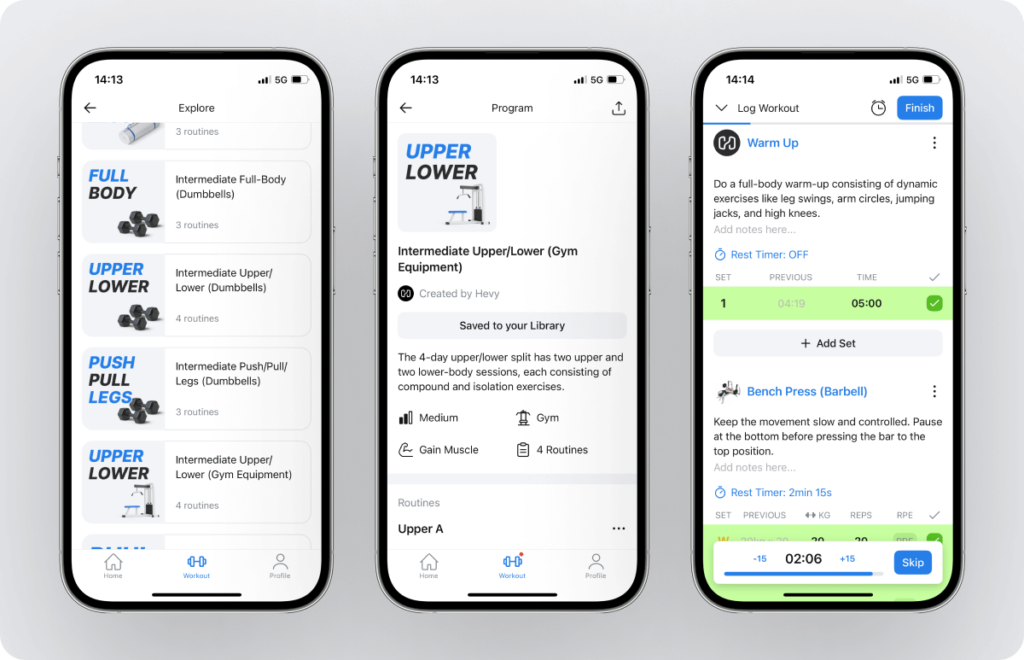

Who Is The Upper/Lower Split For?
As you’ve probably gathered by now, the upper/lower split is incredibly flexible and can benefit people with all sorts of schedules and fitness abilities.
While many people like to label different programs as beginner or advanced, with some tweaking, the upper and lower can work for almost everyone. For example, take the 3-day upper/lower split: it offers a decent training frequency, and you can add a fair amount of training volume. Early intermediates can use it quite well for a long time.


If you’re just getting started with working out, the 2-day split can work fantastic. Have an upper workout on Monday and a lower workout on Thursday, and call it a week. It will be enough for growth, but not too much to feel overwhelmed or overtrained.
If you’re like most people and have the typical recoverability and scheduling flexibility, then the 4-day version will probably work best. You have a consistent schedule, you get to train your muscles twice per week, and there are plenty of opportunities to add training volume.
Rest Days During the Upper/Lower Split
The upper/lower split’s beauty is that it offers numerous scheduling options, allowing you to arrange your recovery days as you wish. For example, if you follow the typical 3-day upper/lower split, you can schedule your recovery days in several ways. For example:
| Week 1 Monday – Off Tuesday – Upper Wednesday – Off Thursday – Off Friday – Lower Saturday – Off Sunday – Upper | Week 2 Monday – Off Tuesday – Off Wednesday – Lower Thursday – Upper Friday – Off Saturday – Lower Sunday – Off |
This is one example where you don’t train on Mondays if you don’t want to. You can also arrange your workouts to have two recovery days in a row if necessary. For example, if you have a hard day at work on Monday and you trained the previous day, you can take two days off and go to the gym on Wednesday.
The 4-day split is also flexible, and you can make it work better for you. For example, if the workweek tends to be incredibly challenging, you can have two light workouts on Tuesday and Thursday, and then do two high-volume workouts on Saturday and Sunday.
Weekly Workout Intensity & Rest
Monday – Off
Tuesday – Upper (light)
Wednesday – Off
Thursday – Lower (light)
Friday – Off
Saturday – (high volume)
Sunday – Lower (high volume)
Most importantly, look at your schedule, recognize potential stressors (e.g., Monday is your most challenging workday of the week), and design your training around them.
What Are The Pros And Cons Of The Upper/Lower?
Like most things, the upper/lower split has its fair share of positives and negatives. Let’s take a look at the most apparent ones:
Pros
- It offers a superior training frequency for most lifters. An ever-growing body of literature suggests that training our muscles twice per week might be more beneficial for long-term improvements (7). With the typical 4-day upper/lower split, you can do that quite well, and you don’t have to maintain an incredibly high training frequency.
- It allows us to improve and maintain movement proficiency much better because we get to perform the different exercises more often throughout the week. For some people, training a lift once per week is not enough, and their strength barely improves because they can’t solidify proper lifting form.
- It’s great for accumulating weekly training volume without overexerting ourselves in any given workout. For example, if you have to do 16 weekly sets for your chest, doing them in two upper-body workouts will be much easier and more sustainable. Consider some of these great chest exercises for women and men.
- It can work great for lifters of all levels, so long as you tweak the training variables correctly. If you’re a complete beginner, you can start with a twice-weekly frequency. Eventually, as you become more advanced, you can do up to six workouts per week.
- It’s fantastic for preventing volume overlap as you have two distinct workouts – upper and lower. This means the risk of training fatigued muscles too soon is much smaller than in other training splits.
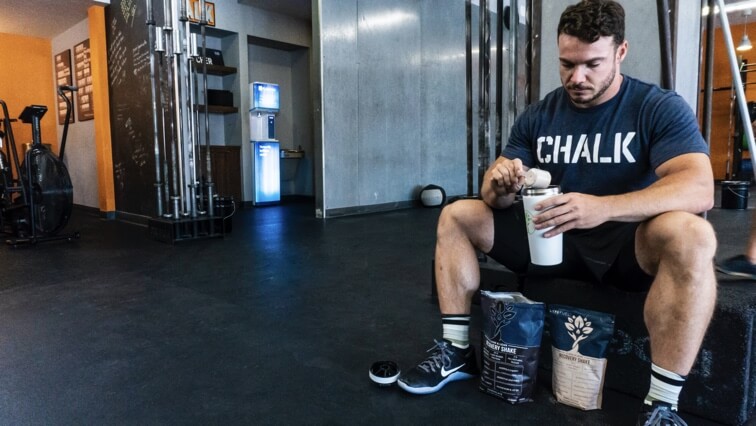

Cons
It wouldn’t be fair to discuss the benefits and completely disregard the potential downsides of the upper/lower split.
With that said, it’s worth noting that the upper/lower split is reasonably balanced and works great for most people. As long as you program intelligently, you won’t run into many drawbacks.
- Your upper body workouts can become long and tedious because there are many muscle groups to target – your back, chest, shoulders, triceps, biceps, traps, upper/lower abs, and obliques. If you do just three sets for your back, chest, shoulders, triceps, and biceps, you’ll still have to do 15 working sets.
- On the other hand, you might find that your lower body workouts tend to finish much quicker, as there are fewer muscle groups to train. Because of that, you might find a hybrid approach to be better. In other words, if you’re adamant about doing direct work for your traps, abs, obliques, and forearms, you might consider adding them to your lower body days.
- You will have to make some tradeoffs in terms of priority. For example, the bro split offers us the chance to give each muscle priority within the training week. On an upper/lower split, you have to pick one muscle group and put the remaining ones on the back burner. For example, you can start with the bench press, but you won’t do your rows in a fully recovered state.
- Typically, our workouts have a single warm-up that consists of a bit of cardio to get the blood flowing, dynamic work to loosen us up, and warm-up sets to work up to our training weights. For the most part, the upper/lower split follows the same directive. But, if you do, say, heavy rows after bench press, it’s good to include a few warm-up sets for that second exercise, which can lengthen your workouts.
Progression With Upper/Lower Workouts
The upper/lower split can work with sophisticated progression schemes. But, for the average lifter, a basic linear progression model will be more than enough (9). In one of the previous points, we shared a few sample workouts and prescribed various repetition ranges for each exercise.
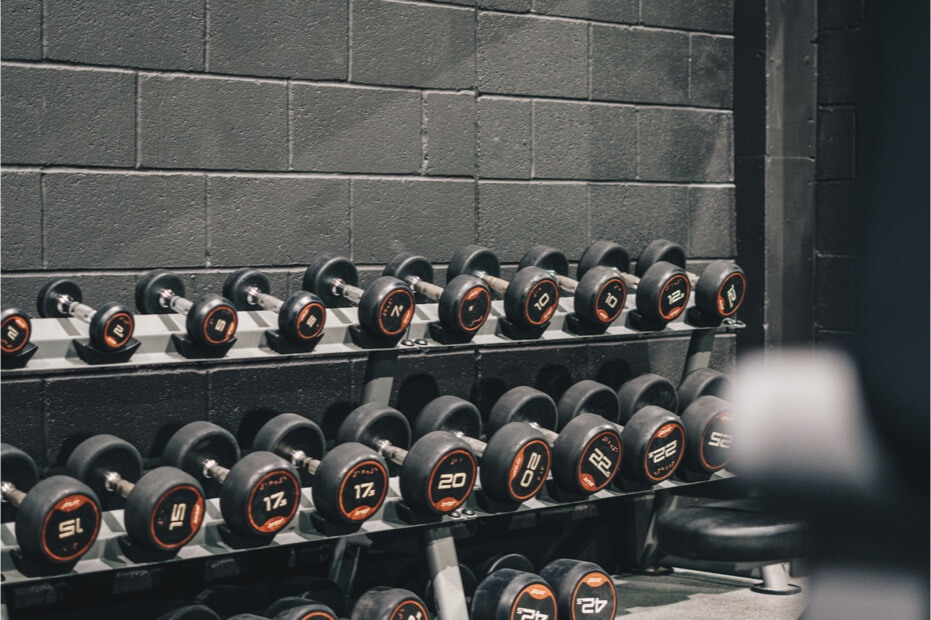
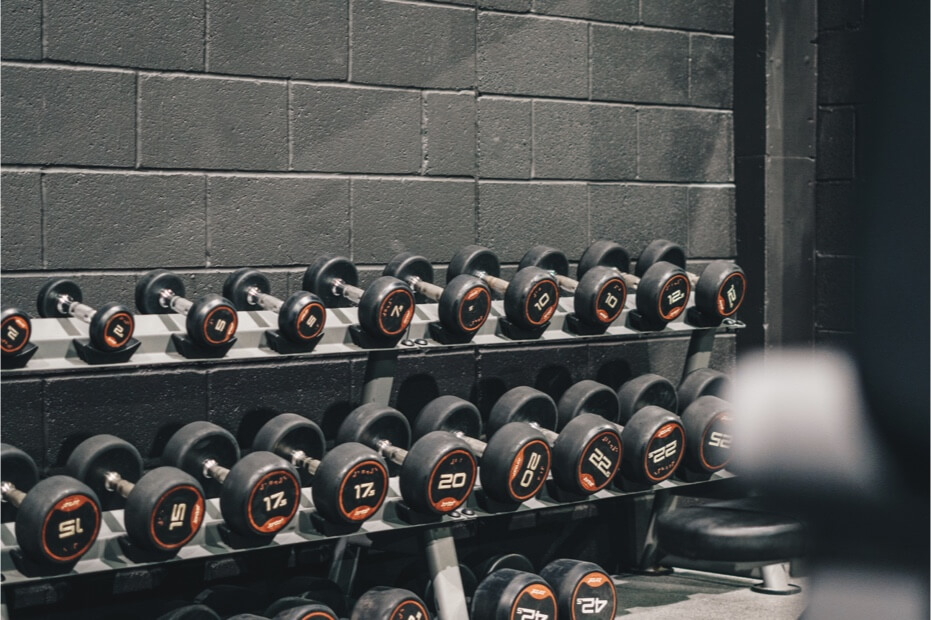
The goal is to set rough guidelines for each exercise and start working toward the upper range. Once you’ve covered your repetition goals for every set, increase the weight for the next workout.
Say, for example, that you’ve prescribed 6 to 10 reps on the bent-over row, and you start with 115 pounds. Here is how to go about it:
| Upper Workout #1 (115 pounds): Set 1 – 10 reps Set 2 – 9 reps Set 3 – 7 reps Set 4 – 6 reps | Upper Workout #2 (115 pounds): Set 1 – 10 reps Set 2 – 10 reps Set 3 – 8 reps Set 4 – 6 reps | Upper Workout #3 (115 pounds): Set 1 – 10 reps Set 2 – 10 reps Set 3 – 10 reps Set 4 – 8 reps | Upper Workout #4 (115 pounds): Set 1 – 10 reps Set 2 – 10 reps Set 3 – 10 reps Set 4 – 10 reps | Upper Workout #5 (125 pounds): Set 1 – 8 reps Set 2 – 7 reps Set 3 – 6 reps Set 4 – 6 reps |
As you can see, at #4, once we could do 10 reps of the exercise, we add more weight and repeat the cycle. This linear model can work for every exercise you do, as long as you’re consistent, and it will produce impressive results in the long run.
Of course, it’s also essential to stay as objective as possible and ensure that your technique remains solid week after week. If you start compromising technique for the sake of lifting more weight, you will eventually find yourself ego lifting and thinking that you’ve gotten stronger.
How Long Should I Train to See Results?
This is one of the most common questions beginners ask, and it’s a bit difficult to answer. How quickly you can see results depends on multiple factors, including your training. Genetics, consistency, effort level, nutritional quality, sleep habits, and life stressors all play roles in the equation.
How well (or poorly) you track your progress also matters. You might be making good progress, but may not realize it and think you’re stuck if you track it well.
The Hevy app comes with built-in analytics to track your performance on each exercise you log (for instance, the number of reps you do and the weight you lift), monitor your sets per muscle, and see how your total volume is distributed among the different body parts.
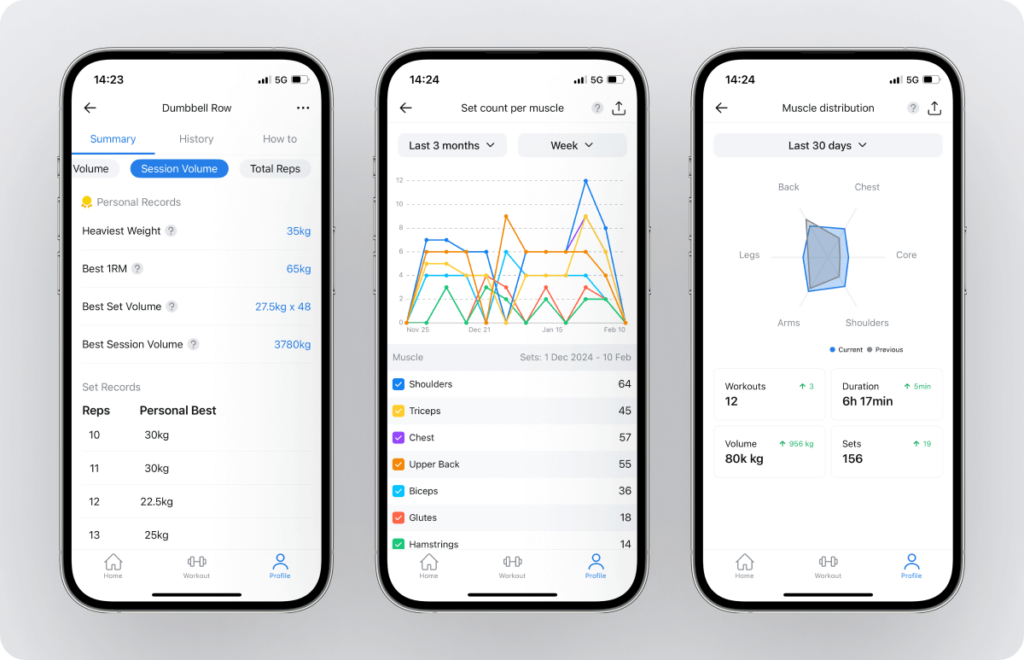

On the other hand, some folks believe that they are progressing well when they aren’t. For example, some people overeat, gain a lot of fat, and think that it’s mostly muscle – this is the well-known dirty bulk.
To say that you should expect results in a given amount of time would mislead you. The truth is, no person can predict that. What we can do, however, is give you rough guidelines.
According to a scale Lyle McDonald made a while ago, a beginner can expect to build as much as 20 to 22 pounds of muscle mass within the first year of training. In year two, that growth rate is cut in half – around 10-11 pounds in twelve months.
After that, muscle growth slows down even more, and we can typically expect to build no more than five pounds of muscle in a year of training.
So, answering the question, “How long should I train to see results?” is difficult. If you’re a beginner and dedicate yourself to a solid split and nutritional plan, you should see progress within weeks. If you’re more advanced, it will take you longer to see positive results. We’ve done an analysis of Hevy users who track their workouts, and it turns out they’ve gotten stronger.
Upper Lower – Training Plan Comparisons
Upper/Lower vs. 3-Day Full Body Split


The 3-day split (also known as a full-body split) is excellent for beginners and early intermediates because it allows them to train each muscle three times per week. What’s more, the 3-day split allows new lifters to learn proper training form more quickly because it exposes them to different exercises more often.
Virtually all good beginner training programs revolve around full-body training concepts because they offer incredible versatility, work great with linear progression models, and the individual workouts aren’t that high in volume.
The upper/lower split, on the other hand, is typically used for a 4-day program and is better suited for intermediate lifters. Advanced lifters can also use the upper/lower split and train five or six times a week to add more volume.
Both splits offer their unique advantages and disadvantages. Which one you choose will mostly depend on your current situation, future goals, and preferences.
If you’re a beginner just starting, a 3-day full-body split or a 3-day classic bodybuilder split will probably be better. But if you’re past that stage and you’ve mostly exhausted your newbie gains, then the upper/lower split will be a better choice.
Upper/Lower vs. Push/Pull/Legs
The push/pull/legs is another popular split used by many, and it’s more similar to the upper/lower than people imagine.
In essence, the push/pull/legs and upper/lower splits are identical. The primary difference is that you combine your push and pull workouts into one upper session. This allows you to train your upper body muscles in a single workout instead of two.
Both splits offer their unique advantages and disadvantages. For example, the upper/lower split allows you to easily schedule your weekly training with a 4-day frequency. You have a fair amount of flexibility, can easily establish a consistent schedule, and get to train all your muscles twice a week.
The primary downside of the upper/lower split is the way you program your workouts. Most people find that their upper workouts have to be longer than their lower workouts because there are more muscle groups to account for.
On the other hand, the push/pull/legs split allows for easier programming of the individual workouts because you have fewer muscles to account for in each workout. In essence, you’re splitting your upper training into two workouts. The push/pull/legs‘ primary downside is that scheduling your weekly training can be tricky.
Both splits are reliable; you might want to try them out to see which one you prefer.
By the way, the Hevy app’s routine library features multiple upper/lower, 3-day, and push/pull/legs programs for all levels. Download the app and navigate to the Workout tab > Explore. Look through the available plans, save the one you like to your profile, edit training details if necessary, and log the workouts anytime.


Upper/Lower vs. Bro Split
The bro split has been around for a long time, and many people deem it the most optimal way to organize our weekly training.
To a degree, the bro split can be incredibly fun and productive. For example, with a bro split, you focus on individual muscle groups and target them with a variety of exercises and a high volume. Programming your workouts and weekly schedule is easy because the goal is simple: dedicate workouts to the major muscle groups in your body.
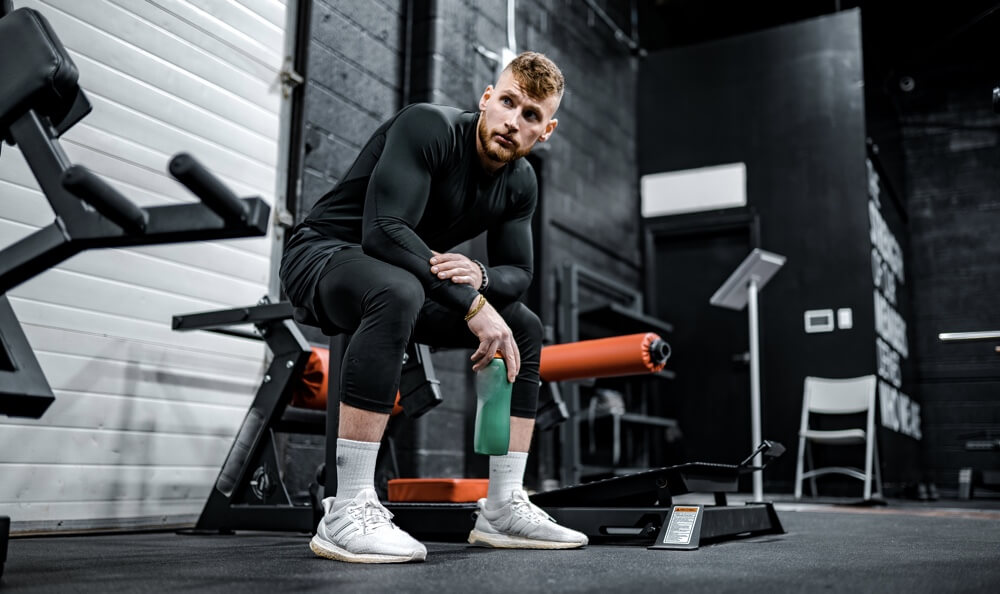
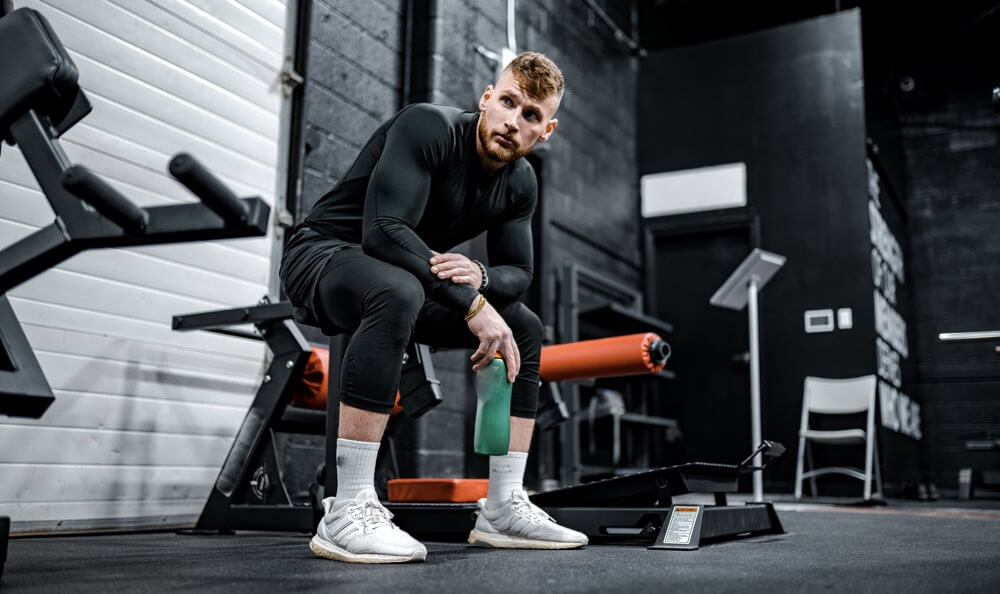
Bro splits also tend to be more engaging for some people because they fatigue their muscles a lot, which can give them a sense of progression, of more effective training, if you will.
The primary downside of the bro split is the low training frequency. According to experts and research, training our muscles only once per week is not enough for optimal muscle growth (11). Because of that, the same folks typically recommend upper/lower or full-body training because they allow for a higher training frequency.
The bro split also requires a higher training frequency – ideally, training five to six days per week, which might not be sustainable for many people.
The upper/lower split is not entirely different, but you get to bundle your shoulder, arm, chest, and back training into one instead of having to dedicate separate workouts for each.
Conclusion
So, what’s the bottom line on the upper/lower split?
One drawback to upper/lower training, as discussed above, is that your upper sessions tend to be longer because you have more muscle groups to work.
On the other hand, lower body sessions are typically shorter. Of course, you can make it work. For example, you can take the hybrid approach and include your direct ab, trap, and forearm training into your lower body workouts.
Hevy Workout Tracker
Create your own workout splits with Hevy, and track your progress. Join 5M+ athletes.



For Personal Trainers
Personal trainer software to build programs for your clients, and track their progress.



If you’re busier and can’t make it to the gym more than four times per week, the upper/lower split might be your best bet. It allows you to train no more than four times a week, do enough volume, and still train all your muscles twice a week.
Combined with a solid nutritional plan, plenty of sleep, consistency, and effort, the upper/lower split can help you achieve fantastic results (10, 12, 13).
Frequently Asked Questions
Here are the seven most frequently asked questions about the upper/lower split:
The upper/lower split is a way of organizing your weekly training by splitting your workouts into distinct upper and lower sessions. For example, you train all major muscle groups in the upper body on an upper day: back, chest, biceps, triceps, traps, and abs. On a lower day, you train all of the lower body’s major muscles – glutes, hamstrings, quads, and calves.
The most common weekly schedule is the 4-day program, consisting of two upper-body and two lower-body workouts.
If your schedule allows, you should do cardio on your rest days. If that’s impossible, you can do cardio at least six hours before or after training. This helps minimize the interference effect (14).
Another alternative is to do cardio after doing your resistance training.

This largely depends on your volume goals for each workout and your weekly training schedule. For example, if you follow the typical 4-day split, you can do two exercises for the chest, back, quads, and hamstrings, and one for the shoulders. You can also do one exercise each for the biceps, triceps, abs, glutes, and calves.
As a whole, doing two to three exercises for your larger muscle groups and one to two for the smaller ones every week is a good rule.
The upper/lower split is superior to other ways of organizing our training, mostly because:
– It’s relatively simple to set up
– It offers a consistent training schedule
– You get to train your muscle groups twice per week
– Accumulating weekly volume is easy
As long as you need to do all of your exercises, sets, reps, and warm-ups. For the average intermediate lifter, this should be somewhere between 50 and 75 minutes.
It can work. However, beginners will likely benefit more from full-body training two to three times a week. This is because the full-body split allows them to learn different movements more quickly, and it’s an excellent way to accumulate enough volume for optimal hypertrophy and strength.
It doesn’t matter much, and you can go either way. It should be mostly based on your schedule, as your upper-body workouts will tend to be a bit longer than your lower-body ones. For example, if you typically have less free time to train on Mondays, you can do your lower-body workout and hit your upper body on Tuesdays.
